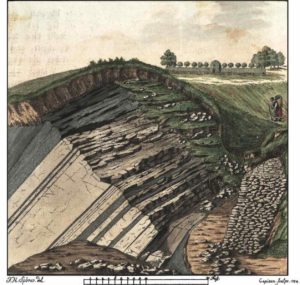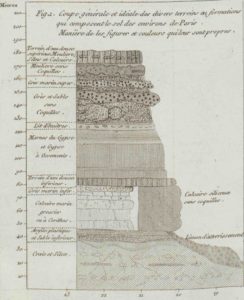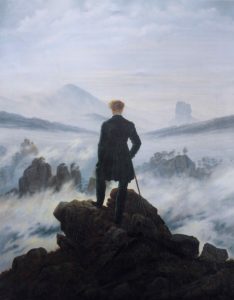Staring into the Abyss of Time
by Stephanie O’Rourke
The essay begins:

Beneath the rock, more rock. It stretches deep into the earth in layered deposits of sandstone and shale, whose limits extend far beyond the edges of the plate. The engraving of the Harz Mountains [above], first published in 1785, depicts the textured surface of a quarry face recessed within a grassy landscape. To the right, a single figure ascends a hill toward a built enclosure. To the left, the curtain of the earth’s surface has been cut away to reveal a hypothetical cross section of its unseen depths. The composition symmetrically divides the realm of the human from that of the geological, with the quarry in the center acting as a fitting intermediary; it is, after all, a site where matter is “unearthed” by human labor and converted into resources. But within a few decades of this print’s publication, the preferred geological illustration of choice looked rather different, as an early example of a “stratigraphic diagram” found in Georges Cuvier and Alexandre Brongniart’s Essai sur la géographie minéralogique des environs de Paris makes clear [right].  Decorative elements borrowed from topographical landscape drawing have been abandoned, and the human figure is excluded altogether. Instead, rock strata are organized along a vertical axis whose annotations reflect both their relative depth and the geological era in which they were thought to have formed. In late eighteenth- and early nineteenth-century stratigraphic diagrams, geological history came into view for the first time, pictured as a function of depth.
Decorative elements borrowed from topographical landscape drawing have been abandoned, and the human figure is excluded altogether. Instead, rock strata are organized along a vertical axis whose annotations reflect both their relative depth and the geological era in which they were thought to have formed. In late eighteenth- and early nineteenth-century stratigraphic diagrams, geological history came into view for the first time, pictured as a function of depth.
The distinctions between these two kinds of illustrations may seem subtle, but the emphasis the stratigraphic diagram placed on geological history reflected a broader scientific preoccupation with the relative age of different rock formations. While not itself antagonistic to human-centric time scales, this kind of illustration participated in the emergence of a new model of geological history that left little room for human history, human agency, or human experience. Whereas the cross section of the Harz Mountains integrated the human scale and the geological scale, whose compositional elements were presented in symmetrical harmony, human elements were purged in later stratigraphic illustrations or relegated to a small detail atop the uppermost strata along with the mise-en-scène of the landscape. In the intervening decades, scientists and savants alike were coming to terms with radically new accounts of how and when the earth was formed. The chronological scale used to measure geological history continually expanded as naturalists attributed ever-greater temporal depths to the rock formations that populated their world. And, correspondingly, human history occupied an increasingly small portion of that geological record; the human figure in [the Harz Mountain] illustration was, in a sense, shrinking. This trend reached its fullest expression in the concept of “deep time” put forward by the Scottish geologist James Hutton in the final decades of the eighteenth century. Hutton proposed that the earth’s formation took place over such a long period of time that it could not even be comprehended in terms of the time scale of human history, rendering human history comparatively inconsequential. As the sweep of geological time grew in the early nineteenth century, “human tenure on the planet” came to seem, in the words of Noah Heringman, “insignificant.” But in other quarters, the geological and the human were still being figured alongside each other.
 Atop the rock, man. The German Romantic artist Caspar David Friedrich, known for his love of the Harz Mountains, pictured a strikingly different early nineteenth-century encounter between the human and the geological in his Wanderer Above a Sea of Clouds. From a granite outcropping, an eponymous wanderer placidly surveys the rocky mountain formations shrouded in mist below him and the faintly rendered peaks that flicker into view in the distance. The figure’s physical elevation over his environment and his panoramic view suggest the fantasy of a geological landscape visually possessed and perhaps also physically mastered by the human subject. Long used as a kind of art-historical shorthand for European Romanticism in general, the painting has more recently been taken as emblematic of a model of early nineteenth-century bourgeois subjectivity concomitant with the rise of modern spectatorial practices: “the ascendancy of newly realized bourgeois aspirations, fantasies of autonomy” that, Jonathan Crary writes, “permitted at least an optical appropriation” of the natural world, if not a literal one. Like Crary’s, a number of influential accounts of the painting grant interpretive priority to how the painting frames the role and status of the human figure qua a perceptual encounter with nature, whether mediated or direct.
Atop the rock, man. The German Romantic artist Caspar David Friedrich, known for his love of the Harz Mountains, pictured a strikingly different early nineteenth-century encounter between the human and the geological in his Wanderer Above a Sea of Clouds. From a granite outcropping, an eponymous wanderer placidly surveys the rocky mountain formations shrouded in mist below him and the faintly rendered peaks that flicker into view in the distance. The figure’s physical elevation over his environment and his panoramic view suggest the fantasy of a geological landscape visually possessed and perhaps also physically mastered by the human subject. Long used as a kind of art-historical shorthand for European Romanticism in general, the painting has more recently been taken as emblematic of a model of early nineteenth-century bourgeois subjectivity concomitant with the rise of modern spectatorial practices: “the ascendancy of newly realized bourgeois aspirations, fantasies of autonomy” that, Jonathan Crary writes, “permitted at least an optical appropriation” of the natural world, if not a literal one. Like Crary’s, a number of influential accounts of the painting grant interpretive priority to how the painting frames the role and status of the human figure qua a perceptual encounter with nature, whether mediated or direct.
Yet as a cursory inspection of the two aforementioned geological illustrations makes clear, this was a period in which the relationship between the human and the natural was undergoing extraordinary changes within mainstream scientific discourses—and in ways that posed significant challenges for the dominance assumed by a very model of subjectivity predicated on the unconstrained visual appropriation of the natural world Friedrich’s protagonist seems to experience. Might this figure be poised not on a precipice but along a widening fault line between conflicting models of historical and natural time? After all, [the Harz Mountain] illustration and Friedrich’s painting are not as intellectually and historically distant from each other as we might assume. Mining and geology were important elements of a constellation of cultural practices within which European Romantic thinkers like Friedrich engaged with and conceptualized nature. “It would have been difficult,” Theodore Ziolkowsi notes, “to assemble a group of intellectuals in any of the centers of German Romanticism without including at least one or two guests who were somehow involved with mining” in the late eighteenth and early nineteenth centuries. Both Johann von Goethe and Georg von Hardenberg (better known as Novalis) were employed overseeing regional mines. Goethe even wrote rapturous lines about geological formations in his 1785 essay “Über den Granit.” As several scholars have noted, Friedrich himself possessed a genuine interest in geology and mountaineering and lived near one of Europe’s foremost centers of geological research for most of his adult life. It is apparent that Friedrich’s work might have both practical and conceptual points of contact with late eighteenth- and early nineteenth-century geological discourse.
From this perspective, we might consider whether several of Friedrich’s works—and especially Wanderer—picture a perceptual encounter between the human and the natural that discloses not the sovereignty of bourgeois subjectivity in this period but rather its precarity in the face of divergent models of historical and natural time. In what follows, I reexamine Friedrich’s art with a particular eye to how it frames nature and history, on its own terms and also in relation to larger trends in German Romantic thought. By placing the “geological” aspects of his work within its broader scientific context, it becomes clear that a model of subjectivity predicated on spectatorship—and particularly the act of observing the natural world—was coming under extraordinary pressure in the early decades of the nineteenth century. As an encounter between the human and the geological, do paintings like Wanderer point toward the ascendance of bourgeois subjectivity or to its imagined annihilation? Continue reading …
Art historian Stephanie O’Rourke here examines the role of geological time in the work of the German Romantic artist Caspar David Friedrich in the early nineteenth century. Her essay foregrounds the challenges this model of time posed for the relationship between the human and the natural—a relationship usually considered central to Friedrich’s work—and for the perceptual powers of the viewing subject.
STEPHANIE O’ROURKE is a Lecturer in Art History at the University of St Andrews, where she specializes in eighteenth- and nineteenth-century European art and visual culture.
